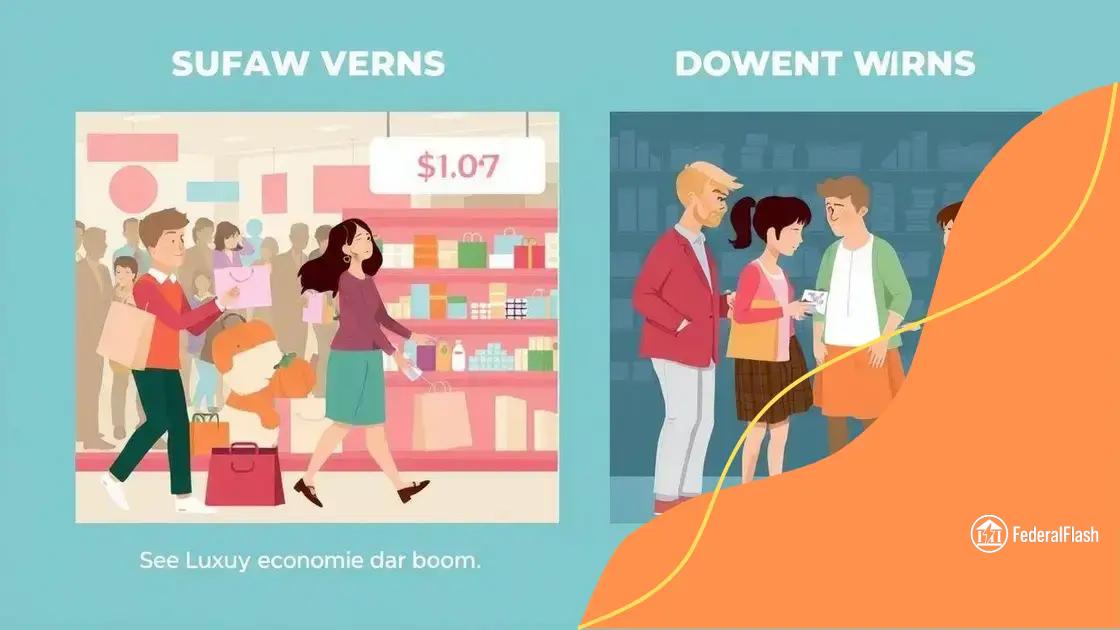Analyzing trends in consumer spending and saving habits

Anúncios
Analyzing trends in consumer spending and saving habits reveals that economic conditions, technology, and budgeting practices significantly influence how individuals manage their finances.
Analyzing trends in consumer spending and saving habits can reveal fascinating insights into our daily choices. Have you ever wondered how economic shifts influence what you buy or save? This exploration is essential for anyone looking to optimize their financial decision-making.
Anúncios
Understanding current consumer spending patterns
Understanding current consumer spending patterns is essential for businesses and individuals alike. It helps us to adapt and make informed decisions in a rapidly changing economy. By examining these patterns, we can discover how consumers allocate their finances across different sectors.
Key Factors Influencing Spending
Some primary factors that shape spending habits include:
- Economic Conditions: The state of the economy directly impacts how much people are willing to spend.
- Consumer Confidence: If consumers feel secure in their jobs and finances, they are more likely to spend.
- Technological Advances: The rise of online shopping has changed how consumers interact with brands.
As we dig deeper, it is crucial to recognize that these patterns often fluctuate due to various external influences. For instance, during economic downturns, consumers tend to prioritize essential goods over luxury items. This shift is not only about preference but also about necessity.
Anúncios
Moreover, different demographics exhibit varying spending behaviors. Younger consumers might favor experiences, like travel and entertainment, while older generations often invest in home improvements or savings. Understanding these shifts can provide valuable insights for marketers aiming to reach specific audiences.
How Demographics Play a Role
Breaking down spending patterns by age, gender, and income reveals compelling trends:
- Millennials: Often invest in technology and experiences, prioritizing convenience.
- Gen Z: Focus on sustainability and social responsibility in their purchasing decisions.
- Baby Boomers: Tend to spend more on healthcare and travel.
Recognizing these distinctions allows businesses to tailor their strategies and product offerings effectively. As we navigate through the complexities of consumer spending, one must consider not just what is being purchased but also the motivations behind those purchases. Are they driven by necessity, desire, or external influences? Various trends indicate that as society evolves, so too do the motivations for spending, making it critical to stay informed.
Factors influencing saving habits today
Understanding the factors influencing saving habits today is crucial for both individuals and policymakers. As the world economy evolves, various elements shape how and why people save money. From financial literacy to external economic conditions, each factor plays a significant role.
Economic Climate
The current economic climate heavily influences saving behaviors. High inflation rates, for example, can lead consumers to save more in anticipation of rising prices. When costs increase, people often cut back on discretionary spending, focusing instead on necessities and saving for the future. Additionally, during periods of economic uncertainty, individuals may prioritize building their savings to create a financial safety net.
- Inflation: Rising prices often lead to increased saving as individuals prepare for future expenses.
- Job Security: Concerns about employment stability can drive people to save more.
- Interest Rates: Higher interest rates can incentivize saving, as individuals earn more on their savings accounts.
On the other hand, when the economy is stable and job growth is strong, many might feel comfortable investing their money rather than simply saving it. Thus, the economic environment directly affects saving habits, as people’s priorities shift based on their circumstances.
Psychological Factors
Psychological aspects also play a vital role in how people view saving. Some individuals find comfort in having a financial cushion, while others may struggle with the idea of delaying gratification. The understanding of financial literacy can significantly impact saving behavior as well. Those who are educated about the benefits of saving for emergencies, retirement, and future purchases are more likely to set aside funds consistently.
- Stress and Anxiety: Financial pressures can lead to higher savings as a way to cope.
- Goals and Aspirations: People often save for specific objectives, like buying a house or funding education.
- Social Influences: Peer behaviors can affect one’s saving patterns, as individuals may feel compelled to keep up with others.
As we navigate these complex influences on saving habits, it becomes clear that multiple factors intertwine to shape individual decisions. Understanding these influences not only helps individuals make better financial choices but also aids in developing policies aimed at improving overall savings rates within communities.
Impact of economic conditions on spending

The impact of economic conditions on spending cannot be understated. When the economy is thriving, consumers tend to spend more freely, confident in their financial stability. Conversely, during economic downturns, spending behaviors shift dramatically as individuals become more cautious with their money.
When the Economy is Strong
In times of economic growth, people often feel secure in their jobs and financial situations. This financial confidence encourages spending on luxury items and experiences. Individuals may choose to invest in travel, dining out, or new technologies. This behavior boosts businesses and can fuel further economic growth.
- Increased disposable income: More earnings lead to greater willingness to spend.
- Confidence in job security: Stable jobs foster an environment for higher spending.
- Investment in experiences: Consumers often focus on experiences rather than just commodities.
As a result, companies often experience increased sales, leading to improved profits and even more hiring. This cycle contributes to a robust economy, where spending fuels growth.
Challenges During Economic Downturns
On the other hand, during economic downturns, such as recessions, consumer spending typically decreases. Individuals and families often prioritize saving over spending due to uncertainty about the future. They focus on essentials, postponing major purchases until their financial situations improve.
- Rising unemployment: Job losses lead to reduced disposable income.
- Increased savings rates: Individuals save more as a precaution against uncertainty.
- Redistribution of spending: Consumers might shift purchases toward essential goods.
This reduced spending not only affects individual households but can also lead to slower economic growth. Businesses may respond to decreased consumer demand by cutting back on inventory or reducing staff, further exacerbating unemployment rates.
Overall, it is evident that economic conditions have a direct and profound impact on how and why consumers choose to spend their money. Understanding these dynamics can help businesses anticipate market changes and modify their strategies accordingly.
How technology shapes consumer behavior
How technology shapes consumer behavior is a vital aspect of modern marketing. The rise of digital tools and platforms has transformed the way consumers shop, research products, and make purchasing decisions. As technology advances, so do the ways people engage with brands.
The Influence of E-Commerce
E-commerce has become a dominant force in retail. Today, consumers can shop online from the comfort of their homes. This convenience has changed expectations regarding shopping experiences. With a few clicks, individuals can compare prices and products, read reviews, and make purchases swiftly.
- Convenience: Online shopping provides easy access to a wide range of products.
- Price Comparison: Consumers can quickly compare costs across different retailers.
- Personalization: E-commerce platforms often offer tailored recommendations based on previous purchases.
As a result, brands are under pressure to enhance their online presence and provide seamless shopping experiences. This shift not only affects how products are sold but also influences inventory strategies, marketing approaches, and customer engagement practices.
Social Media’s Role
Social media platforms have also played a significant role in shaping consumer behavior. Many consumers discover products through platforms like Instagram and TikTok. Influencer marketing has become a key strategy for brands looking to reach specific demographics. By leveraging the reach of social media, brands can create buzz and drive conversions.
- Community Engagement: Brands can connect with their audience and build loyalty through interactive content.
- Feedback Channels: Consumers often share their opinions about products, influencing others’ purchasing decisions.
- Real-Time Trends: Trending topics can impact which products consumers are interested in at any given moment.
Ultimately, technology provides tools for businesses to better understand and engage with their customers. As more consumers turn to digital channels for shopping, businesses must adapt to these shifts in behavior. This requires not only understanding the latest technologies but also adapting marketing strategies to leverage these emerging trends effectively.
Tips for adapting to changing spending trends
Adapting to changing spending trends is crucial for both consumers and businesses. As societal norms and economic conditions evolve, maintaining flexibility allows individuals to make smarter financial decisions and brands to effectively meet customer needs. Here are some valuable tips to navigate these shifts.
Stay Informed
One of the best ways to adapt is by staying informed about market trends. Understanding what influences consumer purchases can help you anticipate changes in your spending and saving habits. Regularly following industry news and reports can provide insights about economic shifts that may impact your decisions.
- Subscribe to newsletters: Get updates from trusted financial sites to keep track of spending habits.
- Utilize analytics tools: For businesses, using data analytics can reveal consumer behavior patterns.
- Engage with social media: Follow financial influencers and brands to see emerging trends.
By being proactive, consumers can better prepare their budgets and spending while businesses can align their offerings with current demands.
Practice Budgeting
Setting and sticking to a budget is essential in adapting to changing spending trends. Creating a flexible budget allows for adjustments as priorities shift. It gives consumers and businesses a clear picture of their financial situation and helps them prioritize expenses effectively.
- Review monthly expenses: Evaluate where money is spent to identify areas for adjustment.
- Establish savings goals: Regularly set short- and long-term savings objectives.
- Use budgeting apps: Technology can simplify tracking expenses and managing finances.
By budget-conscious practices, consumers can remain adaptable, ensuring that they are prepared for any abrupt changes in their financial landscape.
Embrace Technology
Utilizing technology effectively can also aid in adapting to new spending behaviors. Shopping apps, personal finance tools, and online resources can empower individuals to make informed choices. Businesses must leverage technology to offer better customer experiences and adapt to the modern digital landscape.
- Explore online shopping: Take advantage of convenient platforms for better deals and prices.
- Track spending: Use financial apps to monitor and analyze where money goes.
- Engage with online communities: Forums and groups can provide support and advice on managing finances.
Overall, embracing technology not only streamlines the process of adapting to changes but also enhances the overall financial management experience for both consumers and businesses.
\n
FAQ – Frequently Asked Questions about Consumer Spending and Saving Habits
What are the main factors that influence consumer spending?
Consumer spending is influenced by various factors including economic conditions, consumer confidence, and changing technology, which shape buying behaviors.
How can I adapt my spending habits to economic changes?
To adapt, stay informed about market trends, practice effective budgeting, and embrace technology for better financial management.
Why is budgeting important in changing economic climates?
Budgeting helps track expenses, prioritize spending, and ensures you can adjust to financial changes without stress.
How does technology impact consumer behavior?
Technology enhances convenience in shopping, provides tools for budgeting, and allows for personalized experiences, significantly influencing spending habits.